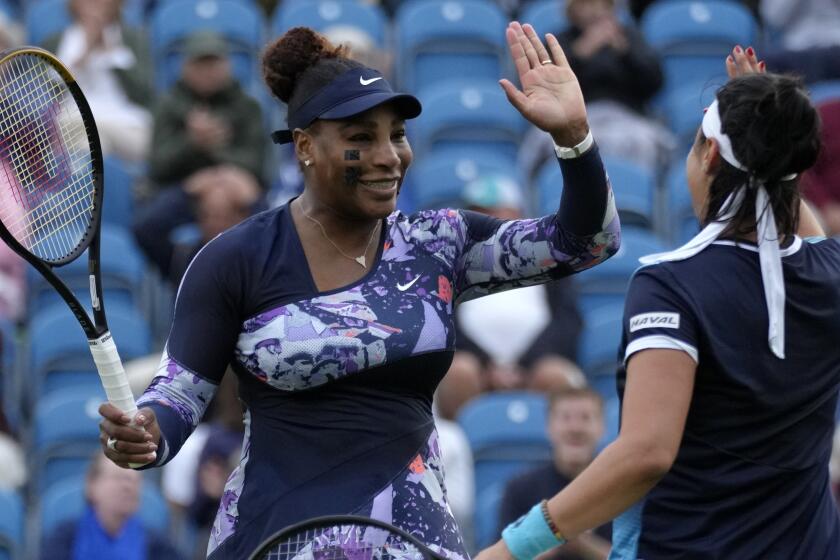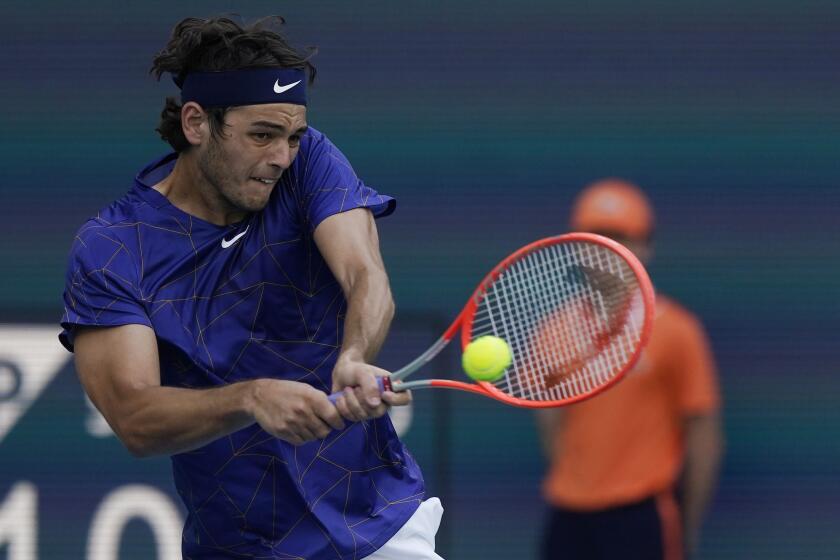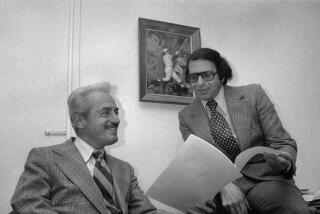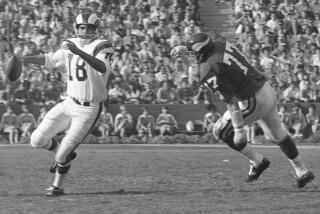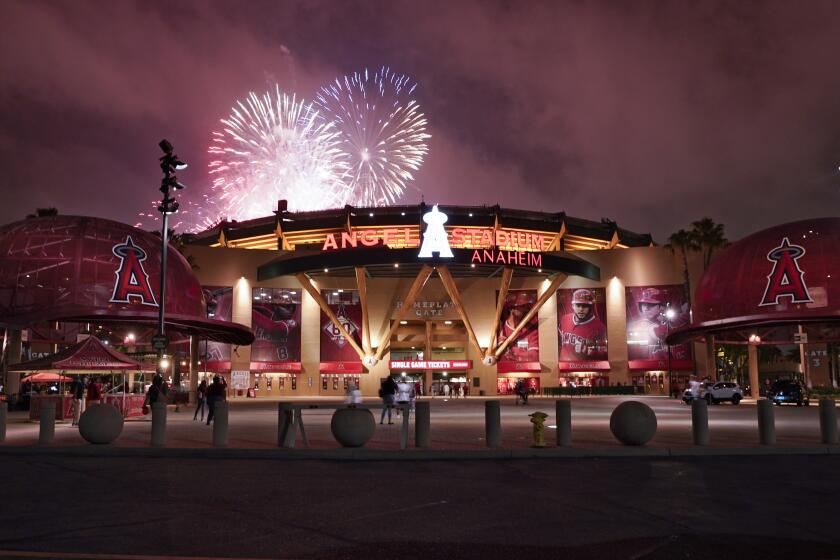Commentary: How Wimbledon legend Jack Kramer ended ‘shamateurism’ and ignited pro tennis movement
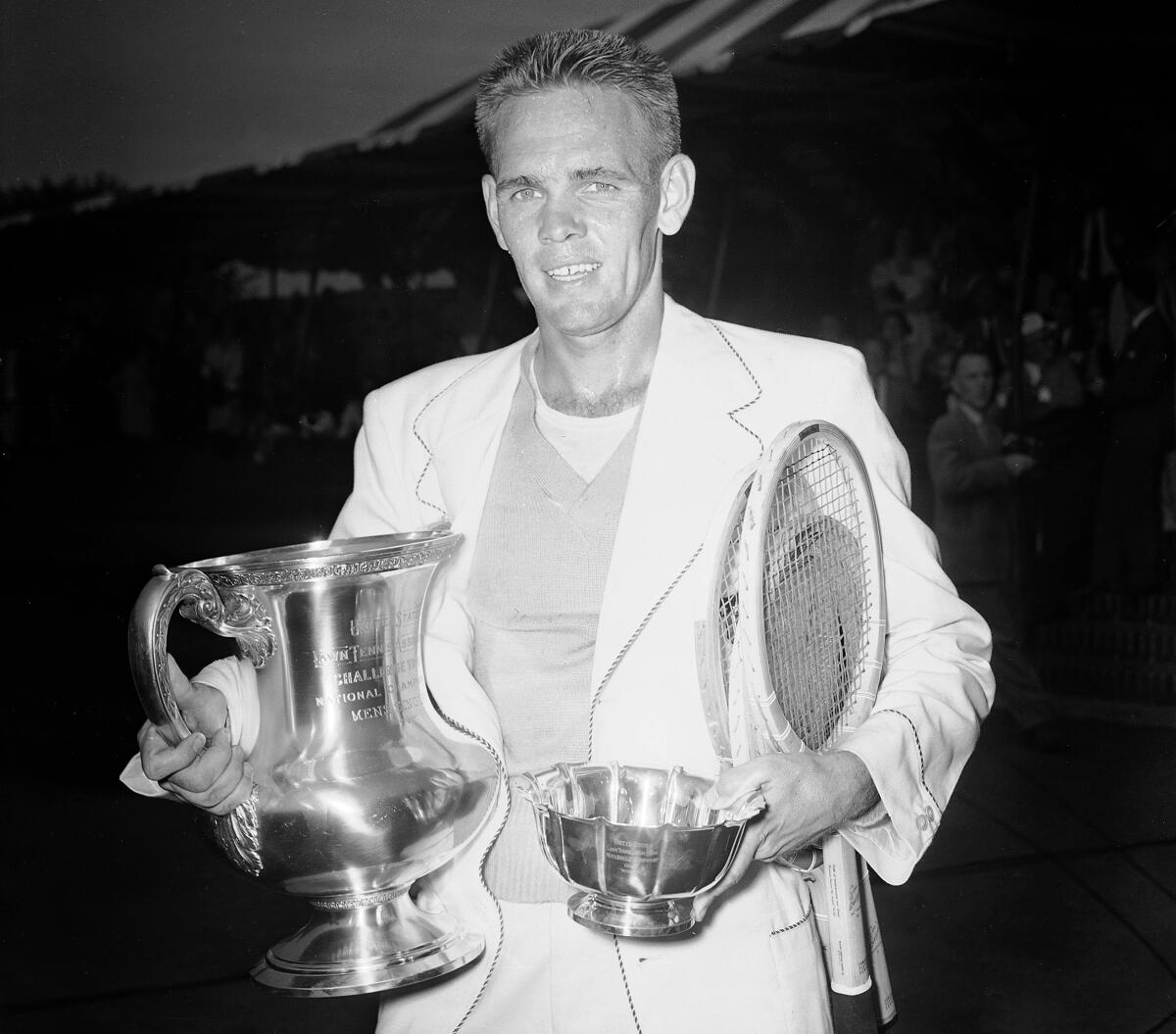
- Share via
In the 1940s and ‘50s, the tennis stars of the world found their gold only on trophy figurines and engraved bowls. Jack Kramer was one of those tennis stars then, and he had a plan to change that.
Seventy-five years ago, in the summer of 1947, he began his plan by winning the men’s singles title at Wimbledon. He beat a Bay Area player named Tom Brown, 6-1, 6-3, 6-2. Brown, later a prominent lawyer, was known as “The San Francisco Flailer.” Little successful flailing in this one. The match took 45 minutes.
Kramer got a nice trophy, back then called the Renshaw Cup, which eventually found its resting place inside the front door of the Kramer residence at 231 Glenroy Place in Bel Air. There, it was used as a convenient drop-off spot for whomever had gone out to the mailbox that day. He also got a nice trophy later that summer of ’47, when he won the U.S. Nationals at Forest Hills. His plan, to win two majors and establish his star power before turning pro, nearly came crashing down in that one. He lost the first two sets of a five-setter to Frankie Parker and memorialized that moment for years.
After a year of speculation about whether Serena Williams was planning to retire, the 23-time Grand Slam event winner wins in a doubles match at Eastbourne.
“I looked into the stands, where my money guy was,” he said, “and all I saw was the top of his head. He was bent down, fearing the worst.”
The worst would have been Kramer losing, which he did not. His comeback victory, paired with doubles titles at both 1947 Wimbledon and the U.S. Nationals — a feat achieved in the same summer only by him, Don Budge and John McEnroe — was the beginning of the end of tennis “shamateurism,” as Kramer called it.
He was a big enough attraction now. He would turn pro, trigger a movement toward players actually getting paid for their work, and lead a revolution in the sport that now brings seven-digit paychecks to winners of major tournaments.
Kramer didn’t quite envision all that. He did know that trophies didn’t buy groceries.
“I needed the money,” he said.
His act of turning pro jolted the sports world. He was a movie-star-like athlete — tall, good-looking and well-spoken. He played a game that was attractive to fans — big serve, closing volley, good-night Irene. He had huge hands and used a racket grip of 5¼ inches. Most male players to this day seldom exceed 4⅝ and some even espouse gripping down to 4½.
He told a reporter that, one time, when an opponent had been especially annoying and he had a chance to serve out the match, he took four tennis balls in his left hand, held them up to show the annoying one what he was holding, then tossed them up, one by one, hitting four aces and walking off.
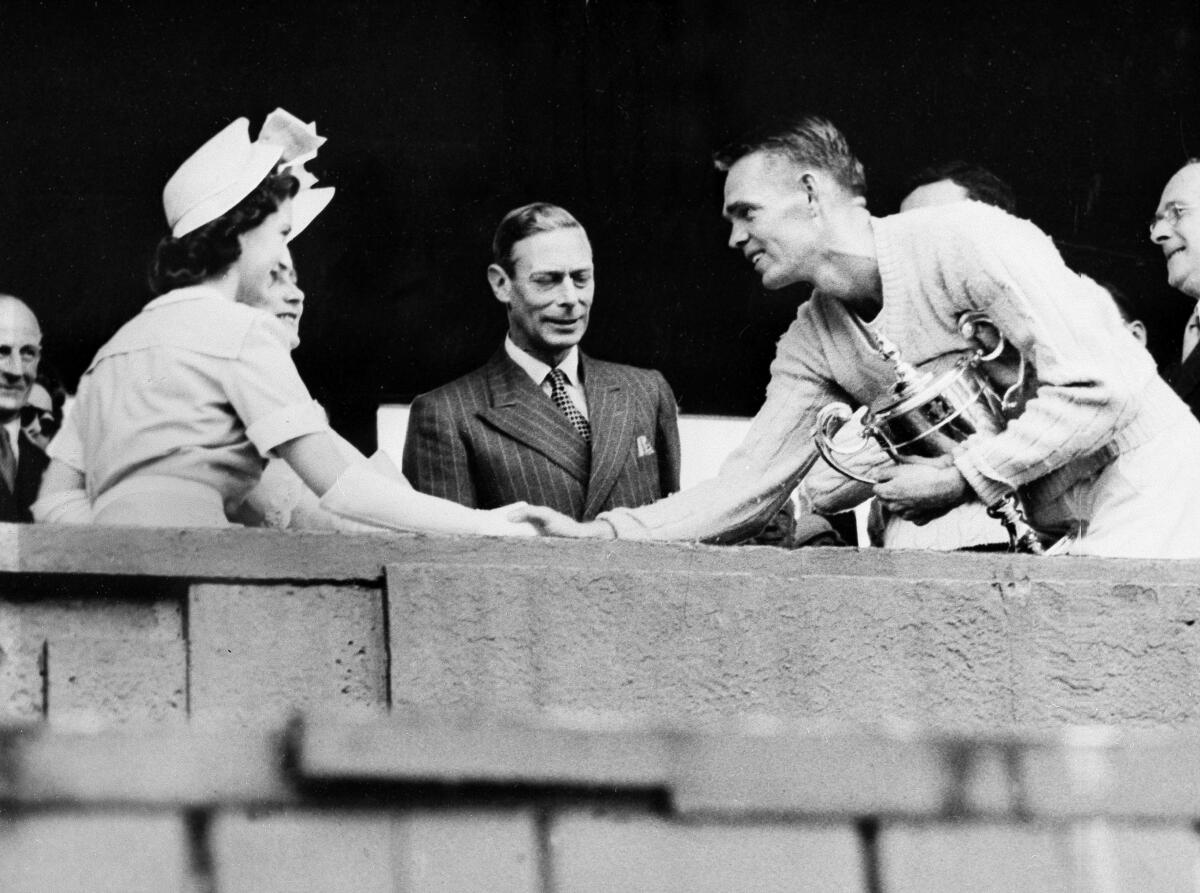
His move to go pro wasn’t quickly embraced. When he returned to Wimbledon to watch and do some broadcasting, he wasn’t even allowed in the gate. When he won, he had been gushed over by the King of England during the trophy presentation and shook the hand of a young lady then known as Princess Elizabeth. Kramer’s son, Bob, remembers him saying about his post-1947 trips to England, “I even had trouble getting a cab in London.”
Slowly, the play-for-pay movement in tennis took hold. Kramer started a traveling tour, where he was matched against the likes of Pancho Gonzalez and Bobby Riggs. On opening night, in the midst of a snowstorm in New York City, Kramer versus Riggs drew 15,114 people at Madison Square Garden.
Soon, the likes of Australian stars Rod Laver and Ken Rosewall ventured into the professional ranks. It wasn’t easy. Tournament directors, while handing out trophies at their events, also had the knack of slipping piles of cash under the table. Australian Roy Emerson, who won 12 major titles, is 85 now and lives in Newport Beach, famously replied to Kramer’s request to turn pro by saying, “I can’t afford to.”
As the 1950s moved into the early 1960s, there were several pro circuits. Texas oilman Lamar Hunt had one of them, and at a news conference where reporters were still struggling with the concept of big-money tennis, Hunt was pressed about the financial challenges he faced. It was speculated that he had lost more than $2 million a year. How long could he go on, he was asked.
“With current projections,” he said, “maybe 150 or 200 years.”
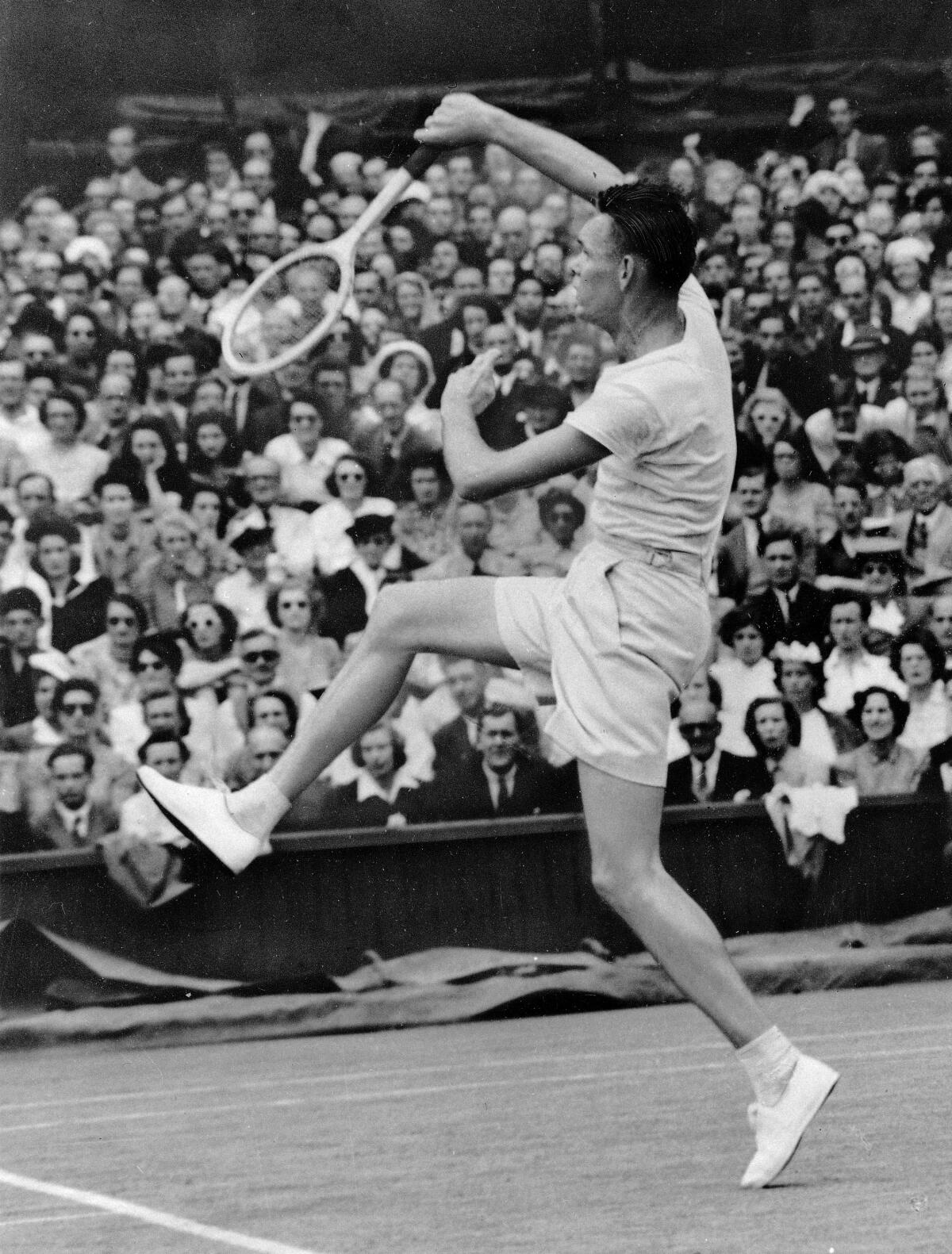
The pro movement was an unstoppable, chugging train. By the early 1970s, Kramer was done barnstorming and headed a group that was the precursor of the current ATP Tour. The likes of Charlie Pasarell, Arthur Ashe and Stan Smith were involved. The movement had brought Open tennis in 1968, but the tours weren’t yet organized enough or carrying the kind of leverage needed to make things as lucrative as they are today.
Kramer became a $1-a-year executive director of the Assn. of Tennis Professionals, a forerunner of the current ATP. In women’s tennis, nine players, led by magazine publisher Gladys Heldman and her daughter, Julie — as well as Billie Jean King — started their own tour in Houston in 1970.
Smith won the 1972 Wimbledon title, 50 years ago. In 1973, Wimbledon stood behind the Yugoslav Tennis Federation’s disqualification of player Niki Pilic for missing the Davis Cup and disqualified him to play at Wimbledon. With Kramer and his ATP group leading the way, most of the top players, including defending champion Smith, boycotted. There was no longer any question. The players were united and organized. Dollar bills would be the currency in tennis, not trophies.
How much credit Kramer should get for all this is difficult to quantify. Longtime tennis journalist and broadcaster Bud Collins once called Kramer “the most important figure in the history of the game.”
COVID-19 took a harsh toll on tennis in Southern California, but the newly launched SoCal Pro Circuit looks to nurture the sport’s budding stars.
Kramer would have scoffed at such hyperbole. He was the son of a railroad man from Las Vegas who moved his family to Montebello, watched his son become a great athlete and recommended he stick with one sport. Kramer went to the Pomona Fairgrounds when he was 13, saw the legendary Ellsworth Vines play, and opted to stick with tennis. At 18, he played on the U.S. Davis Cup doubles team, the youngest at that point to do so.
His quest to pay the family bills never totally materialized on the tennis courts. But when Wilson Sporting Goods asked him to be the celebrity signator for one of their new rackets, the Wilson Kramer brand was born and 30 million rackets eventually were sold. That took care of the family quite nicely and led to, among other things, the purchase of Los Serranos golf course in Chino Hills. When he bought it, it was 18 holes. Now, it is 36 holes, has bunkers with tennis names and a clubhouse full of Jack Kramer memorabilia.
Kramer loved his golf course, and once shocked an audience when he told them: “Tennis is my hobby, but golf is the best game.”
He also had what he called “Five Perfect Sons.” They were, and are, in order: David, John, Bob, Michael and Ron. Their mother Gloria, who died in 2008, always corrected that to “Almost Perfect.”
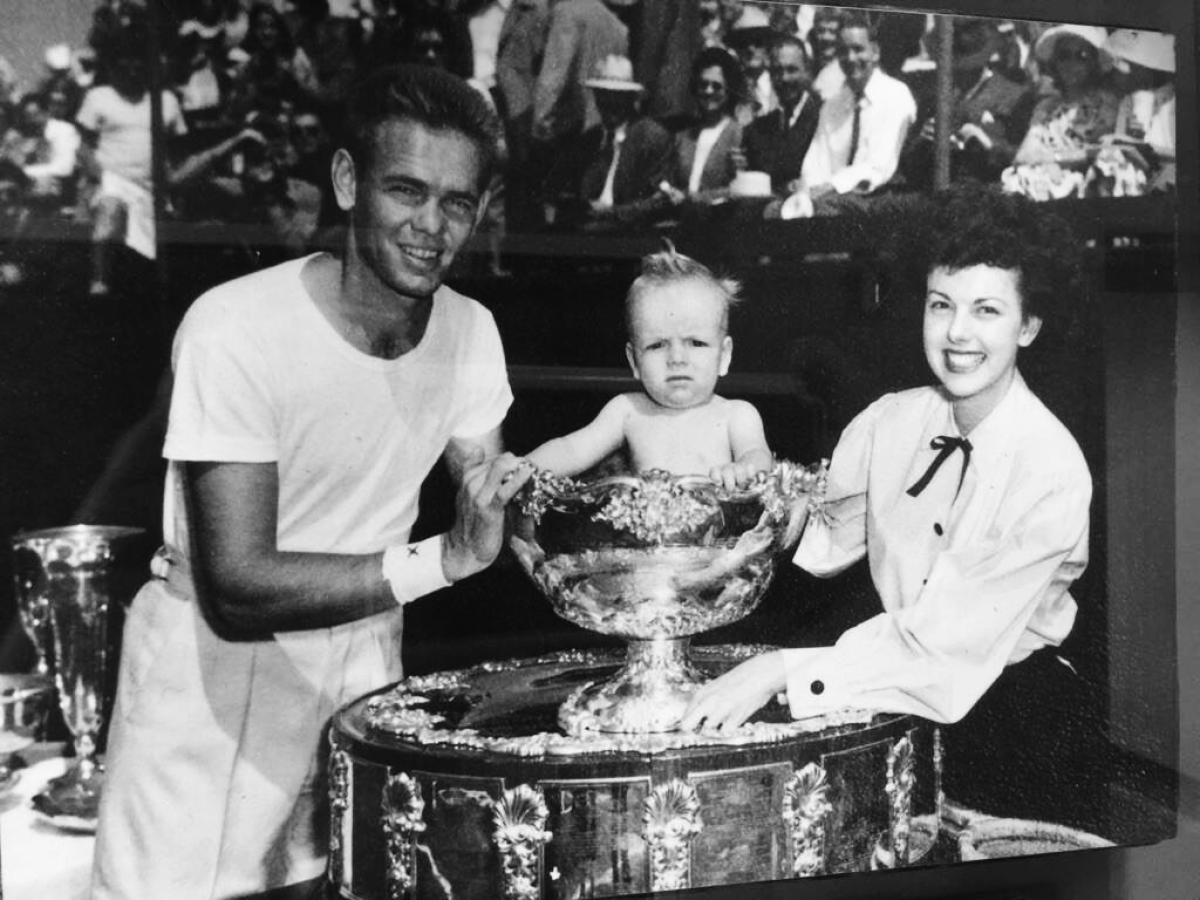
The five perfect sons remain involved in Los Serranos — Ron was the general manager for a few years — and other Kramer enterprises. Bob ran the pro tour stop at UCLA, a tournament that was called, for a few years, the Jack Kramer Open. The event was actually a continuation of the prestigious Pacific Southwest tournament.
The new version eventually settled at UCLA’s Los Angeles Tennis Center. The tournament ended in 2012, when its dates and sanction were purchased by a group in Bogotá, Colombia, where it stayed for three years before moving to Los Cabos in Mexico.
A special joy for Jack Kramer was racehorses. Several times, when he won an event in Australia, the transfer of prize money was so complicated that the Aussies sent him racehorses instead of cash. Bob remembers going to the docks in San Pedro as they were unloaded.
“I always wondered why I couldn’t ride them,” he had said.
Jack Kramer spent hours at Southern California racetracks, many of them with doubles partner and Wimbledon and U.S. national champion Ted Schroeder of San Diego. Schroeder, a practicing cynic and Damon Runyan character, called Kramer “Big Jake” and told endless stories about their paydays at the track. Some of the stories were even true.
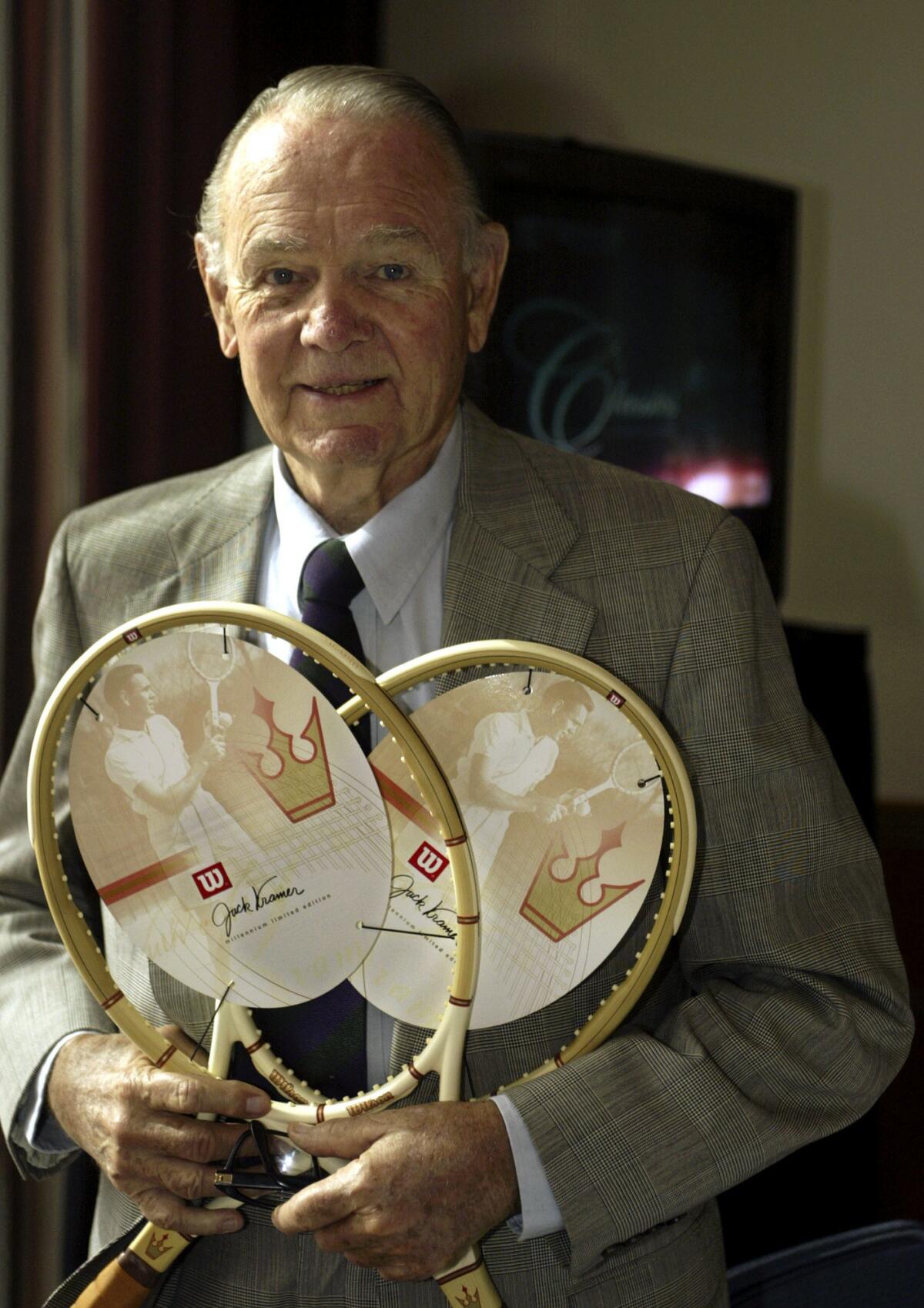
David Kramer, the oldest perfect son, is currently campaigning a thoroughbred named Glenroy, named for the family street in Bel Air.
Even in the months before he died at 88, during the September U.S. Open in 2009, Jack Kramer had become a fixture at Los Serranos, making the long drive from the west side of Los Angeles at least weekly to check the books, see how many golfers had teed off that day and settle in for lunch in front of his favorite big screen TV. He usually was surrounded by friends, a few of his sons and the regular players, and he was in a place he loved.
Interestingly, just down the hall, near the banquet room entrance, there remains evidence that those trophies he fought so long and hard to have replaced with paychecks were indeed worth something. Displayed prominently in one photo is Kramer, holding a Davis Cup trophy. Sitting in the big dish, beaming, is the first perfect son, baby David.
With Jack Kramer’s story as perspective, it is a picture worth at least a thousand words.
More to Read
Go beyond the scoreboard
Get the latest on L.A.'s teams in the daily Sports Report newsletter.
You may occasionally receive promotional content from the Los Angeles Times.
